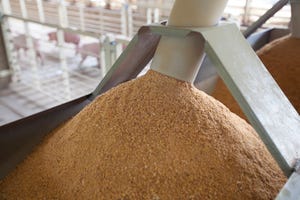Disease control has many facets, and one of those is to reduce the transmission of infectious agents from the dam to the pig, which is often referred to as vertical transmission.
November 9, 2016

Disease control has many facets, and one of those is to reduce the transmission of infectious agents from the dam to the pig, which is often referred to as vertical transmission. So, how do we do this? The easy answer is to start with a “clean” sow herd.
Great progress has been made in producing PRRS, mycoplasma hyopneumoniae, Actinobacillus pleuropneumoniae, Treponema hyodysenteriae, toxigenic Pasteurella, manage and lice free breeding stock so that new herds or repopulations can begin free of these diseases and parasites. And various techniques, procedures, and protocols have been developed to try and eliminate from breeding herds of one or more of these problems.
Due to logistics, economics, or the type of micro-organism, it is not always possible to accomplish the elimination of organisms from the breeding herd. However, with increasing emphasis on antibiotic stewardship, efforts and protocols that can be implemented in breeding herds to reduce downstream vertical transmission of disease will become increasingly important. Since every herd is different, specialized protocols may need to be developed and changed over time, dependent upon the disease, and the severity of the infection level detected in the flow of pigs from sow farms.
This column describes two cases where intervention in the sow herd has helped to reduce disease levels in the pigs.
Case 1
A 3,000 sow herd expanded over several years from an initial base of 600 sows. The expansion was accomplished by adding breeding animals from a new genetic source without repopulation. The original breeding herd was infected with Actinobacillus pleuropneumoniae type 6. (APP 6) Initially this was a farrow-finish herd, and we would diagnose occasional clinical breaks of APP. As the herd expanded, it also converted to breed to wean production selling weaners. Some clinical problems with APP 6 were reported in pigs, but it was not consistent in every group. Tilmicoson was added to the lactation diet to attempt to put some antibiotic pressure on the bacteria.
Over time, the farm developed business partners with which to finish a large portion of the pigs. In at least one of the sites APP occurred with some frequency, causing an acute spike in a group’s mortality rate, but it was not a continuous problem. To try to further reduce the probability of clinical disease in finishers, an injection of DraxxinR was initiated when the pigs were weaned and Tilmicosin was maintained in the lactation diet. The clinical disease in grow-finish has stopped. Recent serology surveys did not detect antibodies in finisher pigs at one site, but some pigs were antibody positive at another finisher location.
There is still evidence of bacterial circulation in the sow herd as new animals develop some antibody reaction by their second parity. This is a case where applying antibiotic pressure against one of the less-virulent APP serotypes at the breeding herd level and very early in the production cycle are helping to control clinical disease in the grow-finish period.
Case 2
The first group of pigs weaned into wean-to-finish barns from a large Indiana sow herd began to show clinical signs of dyspnea, cyanotic ears, and then death at around 10-12 weeks post-weaning. Many of the pigs were in good body condition at the time they died or expressed these clinical signs. Post-mortems on numerous pigs consistently revealed severe vegetative heart valve infections and lesions. A strep-type bacterium was identified from the lesion. This vet hypothesized that the problem was likely related to lack of immunity in the gilt start-up and that it would be unlikely to be an ongoing problem. This vet was wrong!
The clinical problem continued to occur on subsequent groups and persisted even as the sow herd matured. It was estimated that as many as 2% of pigs in some groups might have been affected. The exact numbers were difficult to determine since every pig was not necropsied. Further diagnostic work-up revealed consistent bacteria that were not uniformly categorized by the diagnostic labs. The bacteria were identified as Enterococcus, Strep gallolyticus, or Strep bovis type II by three different labs. This clinician was convinced, however, that the bacteria were the same each time they were isolated.
This was based on sending isolates identified at one lab to another, and each lab was consistent in their naming of the bacteria. Most of the sites where pigs were placed were all-in, all-out by site (and always by building), so the transmission did not appear to be from older to younger pigs. Mass medication of the sow herd, changes in pig processing antibiotic and water medication directed at streptococcus post-weaning did not alter the occurrence of this problem. An autogenous vaccine was made and utilized for approximately two years, and continued emphasis was placed on gilt acclimatization. The incidence in each group of pigs has declined over time and presently is only occasionally noted. The sow herd vaccination has been discontinued.
Although convinced that this condition was being vertically transmitted, this practitioner would not claim that the sow vaccination was the reason for the decline in the problem. It likely was one factor that could have helped, especially since the same strep organism was highly consistent as the cause of the heart valve infections. During this period there was also a change in the breeding stock source which could have helped to alter this condition.
These cases remind us of the importance of the breeding herd in downstream health. They especially challenge us to consider ways to reduce bacterial transmission of disease and pose several questions such as the role bacterial vaccines might play in the reduction of pig flow infection, and can we improve health by reducing micro-organism vertical transmission, even though we likely cannot eliminate many of these agents?
You May Also Like



